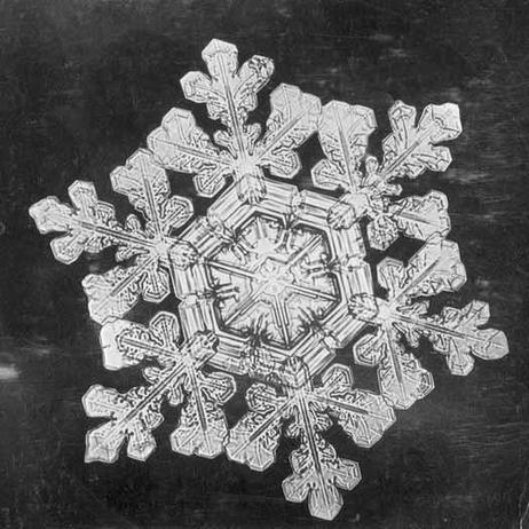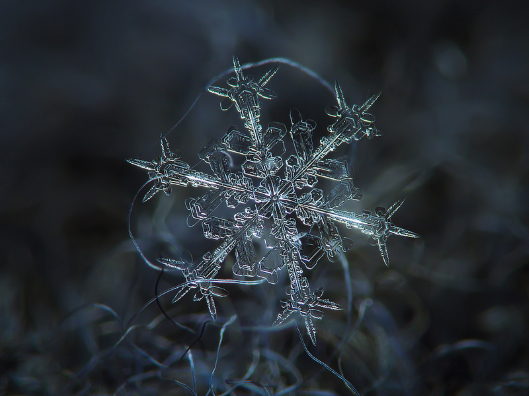They say that there are no two snowflakes the same.
Your reaction to that sentence will be one of three possible scenarios, with the saddest being “What’s a snowflake?” For those of us lucky enough to have see the majesty of a truly white winter, the reaction depends almost entirely on whether you caught an obscure bit of news from 1998. You see, it has long been thought that no two snowflakes are the same, and yet they melt so fast that it’s almost impossible to find out for sure. Until the advent of photography, that is.
On a Vermont farm in January 1885 Wilson Bentley attached a microscope to a bellows camera and took what is widely regarded to be the first photograph of an individual snowflake. Bentley loved the snow and described snowflakes as “tiny miracles of beauty”. His method of photography would go on to be used in the production of his book Snow Crystals, which is still in print today. Unfortunately snow would prove to be the end of him as he died from pneumonia caught while walking home in a blizzard. Bentleys photographs are astounding, even today, with the snowflakes caught against a blackboard background and the level of magnification showing off their intricate design.

The problem with Bentleys photographs was that they were so good, so ahead of their time, that not many people bothered trying to do better. The same techniques, with increasingly better equipment, was used by the National Center for Atmospheric Research in America to try and test the old adage about two snowflakes not being the same. For years they looked and it was assumed that only the simple prism sort of snowflake was able to be replicated in nature until sometime in the 90s they found a twin to one of the previous hollow column sort of snowflakes. A so-called complex snowflake, the sort thought to never be duplicated, had found its twin and the news reported this and the world rejoiced, then went back to grumbling about whatever was worrying us in the 90s – probably mutant killer beetroot men.
Anyway, the image above is from those original 1885 photographs. But there’s been well over a hundred years since those photographs were taken and finally someone has stepped up to the plate and decided to show the world how it can be done with modern technology.

Alexey Kljatov is an amateur photographer, if you can believe that after seeing that shot. In order to save himself thousands on equipment costs, he built his own equipment from old cameras attached to wooden boards using screws and tape. The method was so ad-hoc that it brought to mind those early experiments by Bentley. And, as you can see, it worked amazingly.
Kljatov takes his photos against a glass background or dark woolen material, with light coming from behind. He has a gallery of his snowflake photographs available to view on Flickr. Despite what was learned in the 90s, each one is unique and each one is beautiful.
snow! 😦 Africa is not the place to go if you’re gonna take pictures of snowflakes.
Ok some mountains maybe…sometimes…
*goes to stick his head in the ice-box*
Hmmm, I thought I scheduled this for next week. Odd.
Well, with me around you’ll never need to climb a mountain just to see snow. See how good I am to you guys?
it’s one thing to see it. Quite another to experience it! *came a muffled shout from a icebox somewhere in Africa*
Well, at least you’re trying to experience it…
Strange fellow that one.
You have any idea how hard it is to catch snowflakes without melting them?
Depends where you are. There are methods in some places of the world. I’d love to get a preserved snowflake for Kim.
Sometimes you can see the crystals on your window pane for a period long enugh to get an impression. Of course that is often groups or cloysters (would be cloysters, wouldn’t it?), but it’s also quite a thing to watch them connect. Reminds me of a cartoon I saw once where one snowman looks at this snowflake falling and says to the other showman: “Look at that. A stem cell!”
Ha, sounds like my kinda cartoon.
I used to love the snow, in an old man sipping hot chocolate and looking out the window kind of way. Since I was about nine years old I’ve liked it in that way.
I like snow and ice. I think it’s because I’m born in January. I don’t care much for summer, especially not direct sunlight. It literally burns my skin. I don’t mind the cold, actually. I just put on some wool and skin. Also, no garden chores in the winter time, except for shovelling snow. Nothing wrong in a bit of exercise. Keeps you warm whenm outside in the snow.
What is this “exercise” you speak of?
Are you suffering from demon problems again?
I’m not saying you can’t drive out demons with a snow shovel. It’s just that I’ve seen both Max Von Sydov and Richard Burton fail with coventional means, so…
Weren’t nothing conventional about that…
You’re right. The snowshovel approach would probably qualify as both more convential and efficient than… Well… What they did…
Can we get an extra heater or three in here while we look at the snow?
I’m sorry. Temperatures above ten degrees are hell to me. As your fearless and beloved leader, I cannot allow myself to suffer minor discomforts for my citizens. It would show as much weakness and lack of taste to the world as marrying a Kardashian.
Sorry, I can’t live below 20℃ and shiver below 25℃ :insane:
I’ll just have to watch the snow on T.V. like normal people do! 😛
Good lord, man. Are you made of lava?
Merely born and bred in a World where freezing is what you do to food you don’t want to eat today! 😛
Only a man with no imagination wouldn’t think about keeping his enemies in storage, for later.
Or someone with no enemies… :whistle:
Man with no enemies is man with eyes closed.
– Confuricious
I also like snow and ice! 😀 Even though I have been shoveling snow all day today. 😉
Gotta work for your living. My driveway could do with shovelling actually, but I can’t tell you which one it is. You’ll have to figure that out before the bomb goes off. I’ll send you a list of addresses and you get onto them in order to be a hero and save the world.
Anyone want their driveway shovelled?
We actually haven’t had any real snow around here. Yet. It’s quite extraordinary. Usually we have both snow and ice at this time of year. But Autumn has been particularly hot and wet this year, and King Winter has a hard time getting his foot down this year. So, I won’t be needing any help with the driveway yet. It’s nice and wet right now. Like everything else.
They are right now right here in front of my window. Snowing. Not often seen in Vancouver but occasionally we got some of it. But I can’t tell about the shapes. It’s too dark outside :left:
Are you living thirty days of night? I know that was somewhere snowy and yes, my geography is that bad.
lol It certainly feels that way something 🙂
But yes, we in Canada live in igloos and know not to eat yellow snow 😀
Hurrah! Racial stereotyping!
Ouppsss…. “sometimes” I wanted to say. It’s not even 6am here, I might be still sleepy… :zzz:
Blame it on predictive text. I’ve been doing it for years. 😉
*flies past all the comments* Breathtaking. It’s funny how beautiful things are when zoomed in, and also how ugly they can be too, like bugs.
There really is more than meets the eye to everything. *makes Transforming sound*
That sound is the natural effect of living with me for so long.
Beautiful!